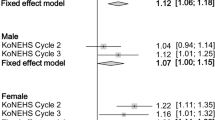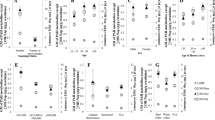Abstract
Investigations into human exposure to bisphenol A (BPA) have, for the most part, assessed intake based on food consumption estimates combined with measurements or estimates of BPA in foods. In this study, nationally representative data on urinary levels of BPA in the United States (US) from the 2003–2004 National Health and Nutrition Examination Survey (NHANES) were used to estimate daily intake of BPA, assuming steady-state excretion. Distributions of intakes for the US population were determined for (i) all NHANES participants with urinary BPA data; (ii) participants by the following age groups: 6–11 years, 12–19 years, 20–39 years, 40–59 years, and 60+ years; and (iii) participants by gender. On the basis of the NHANES urinary BPA data and the assumptions described in this paper, daily BPA intakes for male participants are statistically significantly higher than for female participants, and there are statistically significant differences in daily BPA intakes according to age groups, with the oldest group having the lowest estimated intakes. Median intake was approximately three orders of magnitude below health-based guidance values of 50 μg/kg-day.
This is a preview of subscription content, access via your institution
Access options
Subscribe to this journal
Receive 6 print issues and online access
$259.00 per year
only $43.17 per issue
Buy this article
- Purchase on Springer Link
- Instant access to full article PDF
Prices may be subject to local taxes which are calculated during checkout
Similar content being viewed by others
References
Adibi J.J., Whyatt R.M., Williams P.L., Calafat A.M., Camann D., Herrick R., Nelson H., Bhat H.K., Perera F.P., Silva M.J., and Hauser R. Characterization of phthalate exposure among pregnant women assessed by repeat air and urine samples. Environ Health Perspect 2008; e-pub ahead of print 15 January 2008. doi:10.1289/ehp.10749.
Arakawa C., Fujimaki K., Yoshinaga J., Imai H., Serizawa S., and Shiraishi H. Daily urinary excretion of bisphenol A. Environ Health Prev Med 2004: 9: 22–26.
Badoe E.O., Appeadu-Mensah W., Hesse A., and Maddy S.O. The daily water, sodium and potassium excretion in urine of Ghanaian children aged 5–12 years. West Afr J Med 2005: 24: 231–233.
Boeniger M.F., Lowry L.K., and Rosenberg J. Interpretation of urine results used to assess chemical exposure with emphasis on creatinine adjustments: a review. Am Ind Hyg Assoc J 1993: 54: 615–627.
Calafat A.M., Ye X., Wong L.Y., Reidy J.A., and Needham L.L. Exposure of the U.S. population to bisphenol A and 4-tertiary-octylphenol: 2003–2004. Environ Health Perspect 2008: 116: 39–44.
CDC (Centers for Disease Control and Prevention). 2004 NHANES Analytic Guidelines June. Available at http://www.cdc.gov/nchs/data/nhanes/nhanes_general_guidelines_june_04.pdf, accessed on 11 October 2007.
CDC (Centers for Disease Control and Prevention). 2005 Laboratory procedure manual for bisphenol A, 4-tert-octylphenol, ortho-phenylphenol, 2,4-dichlorophenol, 2,5-dichlorophenol, 2,4,5-trichlorophenol, 2,4,6-trichlorophenol, benzophenone-3, and triclosan. May 25, 2005. Available at http://www.cdc.gov/nchs/data/nhanes/nhanes_03_04/l24eph_c_met_phenols.pdf, accessed on 1 November 2007.
CDC (Centers for Disease Control and Prevention). 2006 General information about the NHANES 2003–2004 laboratory methodology and public data files. January. Available at http://www.cdc.gov/nchs/data/nhanes/nhanes_03_04/lab_c_generaldoc.pdf, accessed on 1 November 2007.
CDC (Centers for Disease Control and Prevention). 2007 National Health and Nutrition Examination Survey 2003–2004 Laboratory Files. Available at http://www.cdc.gov/nchs/about/major/nhanes/nhanes2003–2004/lab03_04.htm, accessed on 11 October 2007.
CERHR. 2007 NTP-CERHR Expert Panel Report on the Reproductive and Developmental Toxicity of Bisphenol A. National Toxicology Program, U.S. Department of Health and Human Services, Research Triangle Park, NC. 26 November. Available at http://cerhr.niehs.nih.gov/chemicals/bisphenol/BPAFinalEPVF112607.pdf, accessed on 13 December 2007.
Dekant W., and Völkel W. Human exposure to bisphenol A by biomonitoring: methods, results and assessment of environmental exposures. Toxicol Appl Pharm 2008, e-pub ahead of print 14 December 2007.
EFSA (European Food Safety Authority). 2007 Opinion of the Scientific Panel on Food Additives, Flavourings, Processing Aids and Materials in Contact with Food (AFC) related to 2,2-bis(4-hydroxyphenyl)propane. Adopted on 29 November 2006. Available at http://www.efsa.europa.eu/EFSA/efsa_locale-1178620753812_1178620772817.htm, accessed on 7 November 2007.
EPA (United States Environmental Protection Agency). 1997 Exposure Factors Handbook, National Center for Environmental Assessment, Office of Research and Development, Volume I — General Factors, Chapter 7 — Body Weight Studies. August, Washington, DC.
EPA (United States Environmental Protection Agency). 2007 Bisphenol A, Integrated Risk Information System. Available at http://cfpub.epa.gov/iris/quickview.cfm?substance_nmbr=0356, accessed on 6 November 2007.
Hauser R., Meeker J.D., Park S., Silva M.J., and Calafat A.M. Temporal variability of urinary phthalate metabolite levels in men of reproductive age. Environ Health Perspect 2004: 112: 1734–1740.
Higuchi M., Miyata D., Kawamura S., Ueda E., Imanaka M., and Tonogai Y. Estimation of daily intake of phenols in hospital meal samples. Shokuhin Eiseigaku Zasshi 2004: 45: 339–343.
Hinwood A.L., Sim M.R., de Klerk N., Drummer O., Gerostamoulos J., and Bastone E.B. Are 24-h urine samples and creatinine adjustment required for analysis of inorganic arsenic in urine in population studies? Environ Res 2002: 88: 219–224.
ICRP. ICRP Publication 89. Basic anatomical and physiological data for use in radiological protection: reference values. July. 280 pp. Elsevier, 2003.
Ihaka R., and Gentleman R. R: a language for data analysis and graphics. J Comput Graph Stat 1996: 5: 299–314.
Kang J., Kondo F., and Katayama Y. Human exposure to bisphenol A. Toxicology 2006: 226: 79–89.
Kissel J.C., Curl C.L., Kedan G., Lu C., Griffith W., Barr D.B., Needham L.L., and Fenske R.A. Comparison of organophosphorus pesticide metabolite levels in single and multiple daily urine samples collected from preschool children in Washington State. J Expo Anal Environ Epidemiol 2005: 15: 164–171.
Maclean's. 2007 Plastic bottles get the eco-boot. N. Macdonald. October 15, 2007. Available at http://www.macleans.ca/science/environment/article.jsp?content=20071015_110188_110188, accessed on 1 November 2007.
Mahalingaiah S., Meeker J.D., Pearson K.R., Calafat A.M., Ye X., Petrozza J., and Hauser R. Temporal variability and predictors of urinary bisphenol A concentrations in men and women. Environ Health Perspect 2008: 116: 173–178.
Matsumoto A., Kunugita N., Kitagawa K., Isse T., Oyama T., Foureman G.L., Morita M., and Kawamoto T. Bisphenol A levels in human urine. Environ Health Perspect 2003: 111: 101–104.
Matt G.E., Hovell M.F., Quintana P.J., Zakarian J., Liles S., Meltzer S.B., and Benowitz N.L. The variability of urinary cotinine levels in young children: implications for measuring ETS exposure. Nicotine Tob Res 2007: 9: 83–92.
McDiarmid M.A., Hooper F.J., Squibb K., and McPhaul K. The utility of spot collection for urinary uranium determinations in depleted uranium exposed Gulf War veterans. Health Phys 1999: 77: 261–264.
Miyakawa H., Kaneko R., and Kamata K. Determination of bisphenol A in canned meat and marine products. Tokyo-to Kenko Anzen Kenkyu Senta Kenkyu Nenpo 2006: 57: 231–233.
Miyamoto K., and Kotake M. Estimation of daily bisphenol A intake of Japanese individuals with emphasis on uncertainty and variability. Environ Sci 2006: 13: 15–29.
Mueller E., Latini J., Lux M., Stablein U., Brubaker L., Kreder K., and Fitzgerald M.P. Gender differences in 24-h urinary diaries of asymptomatic North American adults. J Urol 2005: 173: 490–492.
PBS. 2007 Newshour with Jim Lehrer. Chemical used in household plastics sparks concerns. Aired on 30 October 2007. Available at http://www.pbs.org/newshour/bb/health/july-dec07/bottle_10-30.html, accessed on 31 October 2007.
RockyMountainNews.com. 2007 Deep Rock pulls its plastic jugs. 1 November 2007. Available at http://www.rockymountainnews.com/drmn/other_business/article/0,2777,DRMN_23916_5736489,00.html, accessed on 1 November 2007.
Rugg-Gunn A.J., Nunn J.H., Ekanayake L., Saparamadu K.D., and Wright W.G. Urinary fluoride excretion in 4-year-old children in Sri Lanka and England. Caries Res 1993: 27: 478–483.
Scher D.P., Alexander B.H., Adgate J.L., Eberly L.E., Mandel J.S., Acquavella J.F., Bartels M.J., and Brzak K.A. Agreement of pesticide biomarkers between morning void and 24-h urine samples from farmers and their children. J Expo Sci Environ Epidemiol 2007: 17: 350–357.
Sunday Star Times. 2007 Breast cancer link to plastic. M.J. Boland. Sunday, 21 October 2007. Available at http://www.stuff.co.nz/4245687a11.html, accessed on 1 November 2007.
Taylor E.N., and Curhan G.C. Body size and 24-h urine composition. Am J Kidney Dis 2006: 48: 905–915.
Taylor E.N., and Curhan G.C. Differences in 24-h urine composition between black and white women. J Am Soc Nephrol 2007: 18: 654–659.
Teitelbaum S.L., Britton J.A., Calafat A.M., Ye X., Silva M.J., Reidy J.A., Galvez M.P., Brenner B.L., and Wolff M.S. Temporal variability in urinary concentrations of phthalate metabolites, phytoestrogens and phenols among minority children in the United States. Environ Res 2008: 106: 257–269.
Thomson B.M., and Grounds P.R. Bisphenol A in canned foods in New Zealand: an exposure assessment. Food Addit Contam 2005: 22: 65–72.
Tsai W.T. Human health risk on environmental exposure to Bisphenol-A: a review. J Environ Sci Health C Environ Carcinog Ecotoxicol Rev 2006: 24: 225–255.
Tsukioka T., Terasawa J., Sato S., Hatayama Y., Makino T., and Nakazawa H. Development of analytical method for determining trace amounts of BPA in urine samples and estimation of exposure to BPA. J Environ Chem 2004: 14: 57–63.
USA Today. 2007 “Everywhere chemicals” in plastics alarm parents. E. Weise and L. Szabo. 31 October 2007. Available at http://www.usatoday.com/news/health/2007-10-30-plastics-cover_N.htm, accessed on 1 November 2007.
Valentin J. Basic anatomical and physiological data for use in radiological protection: reference values: ICRP Publication 89. Ann ICRP 2002: 32: 1–277.
Völkel W., Bittner N., and Dekant W. Quantitation of bisphenol A and bisphenol A glucuronide in biological samples by HPLC-MS/MS. Drug Metab Dispos 2005: 33: 1748–1757.
Völkel W., Colnot T., Csanady G.A., Filser J.G., and Dekant W. Metabolism and kinetics of bisphenol A in humans at low doses following oral administration. Chem Res Toxicol 2002: 15: 1281–1287.
vom Saal F.S., Belcher S.M., Guillette L.J., Hauser R., and Myers J.P. Chapel Hill Bisphenol A Expert Panel Consensus Statement: integration of mechanisms, effects in animals and potential impact to human health at current exposure levels. Reprod Toxicol 2007: 24: 131–138.
Willhite C.C., Ball G.L., and McLellan C.J. Derivation of a bisphenol A oral reference dose (RfD) and drinking-water equivalent concentration. J Toxicol Environ Health B Crit Rev 2008: 11: 69–146.
Wilson N.K., Chuang J.C., Morgan M.K., Lordo R.A., and Sheldon L.S. An observational study of the potential exposures of preschool children to pentachlorophenol, bisphenol-A, and nonylphenol at home and daycare. Environ Res 2007: 103: 9–20.
Zohouri V., Moynihan P.J., Hindmarch P.N., Hatts J., and Maguire A. 24-Hour urinary fluoride excretion in British children aged 6 years, 2005. The IADR/AADR/CADR 83rd General Session (9–12 March 2005). Available at http://iadr.confex.com/iadr/2005Balt/techprogram/abstract_62380.htm.
Acknowledgements
This work was supported by the Polycarbonate/BPA Global Group. However, the findings and conclusions in this paper are those of the authors, and not necessarily represent the views of the Polycarbonate/BPA Global Group.
Author information
Authors and Affiliations
Corresponding author
Rights and permissions
About this article
Cite this article
Lakind, J., Naiman, D. Bisphenol A (BPA) daily intakes in the United States: Estimates from the 2003–2004 NHANES urinary BPA data. J Expo Sci Environ Epidemiol 18, 608–615 (2008). https://doi.org/10.1038/jes.2008.20
Received:
Accepted:
Published:
Issue Date:
DOI: https://doi.org/10.1038/jes.2008.20
Keywords
This article is cited by
-
Ten bisphenol analogues in Chinese fresh dairy milk: high contribution ratios of conjugated form, importance of enzyme hydrolysis and risk evaluation
Environmental Science and Pollution Research (2023)
-
Bayesian inference of chemical exposures from NHANES urine biomonitoring data
Journal of Exposure Science & Environmental Epidemiology (2022)
-
Exposure forecasting – ExpoCast – for data-poor chemicals in commerce and the environment
Journal of Exposure Science & Environmental Epidemiology (2022)
-
Carcinogenic Risk Assessment among Children and Adult due to Exposure to Toxic Air Pollutants
Environmental Science and Pollution Research (2022)
-
Insights into the Regulation on Proliferation and Differentiation of Stem Leydig Cells
Stem Cell Reviews and Reports (2021)



